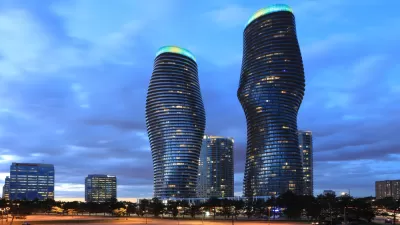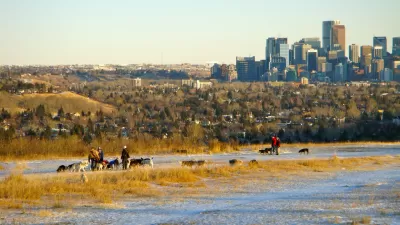As one of North America's largest suburbs, Mississauga is joining some of its neighbors in the Greater Toronto Area in planning an unprecedented effort to replace its suburban roots with something more urban.
Like much of North America, Canada's suburbs have long sprawled in the form of residential subdivisions and automobile-friendly commercial strip development. Now, several suburbs outside of Toronto, including Vaughan, Markham, and Mississauga, are looking to transform their centers into distinctive, walkable, mixed-use neighborhoods.
"What these municipalities are trying to do is unprecedented on this scale in North America. The idea – placing mini-downtowns in far-flung locations, separated from inner-city Toronto by vast stretches of tract housing – runs counter to the traditional model of urban growth," says Adrian Morrow, of The Globe and Mail. "Not everyone is convinced it will work."
Some think bringing downtown-like development to the suburbs is the wrong model. "'To me, it's mildly insane – it's like building more subdivisions,' says Robert MacDermid, an expert in municipal politics at York University. 'Instead, you should be intensifying from the core [of Toronto] outward.'"
Still, many see densification as a necessity. As Morrow notes, "simply sitting back and allowing development to happen where it will – the post-war paradigm in this country – is not an option for those who want to build better cities."
"'We're directing growth where it needs to happen -- not just where the market takes it. That's how you get quality development at the end of the day. We want to take the time to get it right,' says Marilyn Ball, Mississauga's director of development and design. 'We are writing the book on a suburban municipality's shift to a vibrant city.'"
FULL STORY: How Toronto’s suburbs are trying to switch from subdivisions to density

Planetizen Federal Action Tracker
A weekly monitor of how Trump’s orders and actions are impacting planners and planning in America.

Restaurant Patios Were a Pandemic Win — Why Were They so Hard to Keep?
Social distancing requirements and changes in travel patterns prompted cities to pilot new uses for street and sidewalk space. Then it got complicated.

Map: Where Senate Republicans Want to Sell Your Public Lands
For public land advocates, the Senate Republicans’ proposal to sell millions of acres of public land in the West is “the biggest fight of their careers.”

Maui's Vacation Rental Debate Turns Ugly
Verbal attacks, misinformation campaigns and fistfights plague a high-stakes debate to convert thousands of vacation rentals into long-term housing.

San Francisco Suspends Traffic Calming Amidst Record Deaths
Citing “a challenging fiscal landscape,” the city will cease the program on the heels of 42 traffic deaths, including 24 pedestrians.

California Homeless Arrests, Citations Spike After Ruling
An investigation reveals that anti-homeless actions increased up to 500% after Grants Pass v. Johnson — even in cities claiming no policy change.
Urban Design for Planners 1: Software Tools
This six-course series explores essential urban design concepts using open source software and equips planners with the tools they need to participate fully in the urban design process.
Planning for Universal Design
Learn the tools for implementing Universal Design in planning regulations.
Heyer Gruel & Associates PA
JM Goldson LLC
Custer County Colorado
City of Camden Redevelopment Agency
City of Astoria
Transportation Research & Education Center (TREC) at Portland State University
Camden Redevelopment Agency
City of Claremont
Municipality of Princeton (NJ)





























